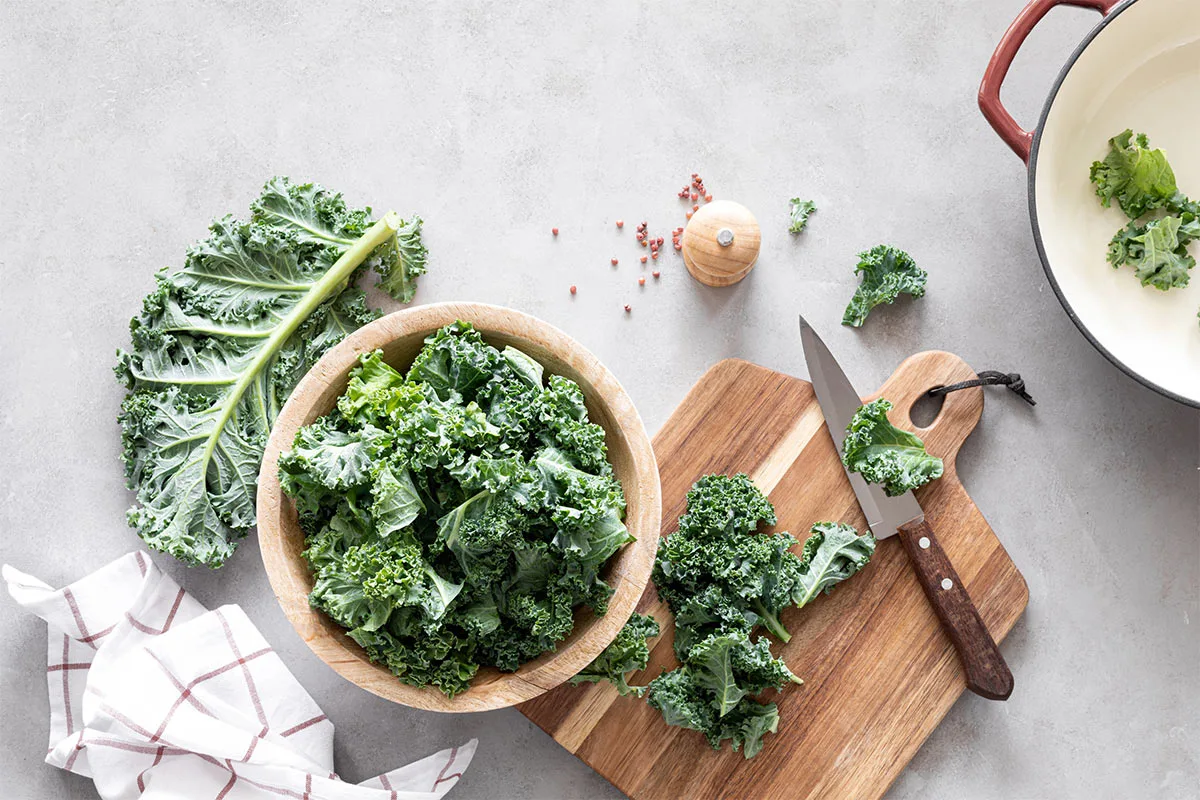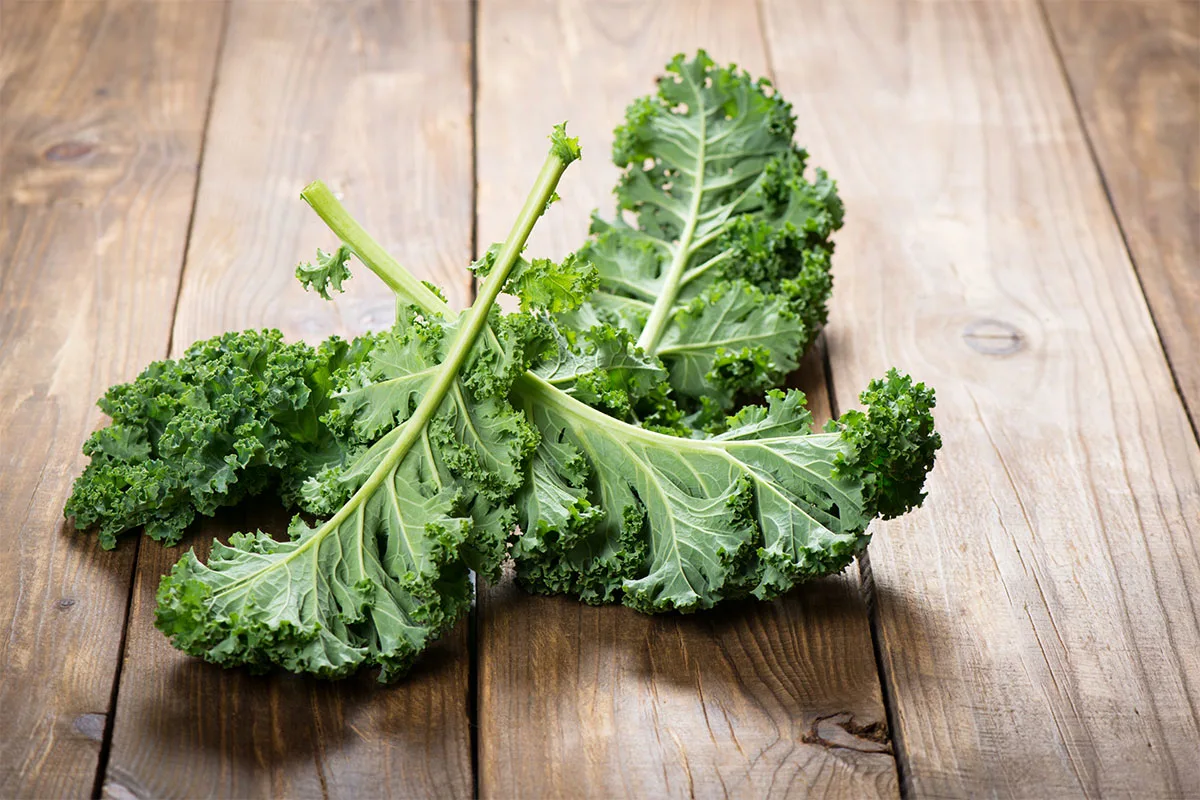It’s possible to find a kale substitute that will offer similar taste and health benefits.
If you’re looking for ways to replace this leafy green in your recipes, welcome!
I’ll show you some of the best kale substitutes, their nutritional profile and ways to use them in cooking.
Jump to:

What’s kale?
Let’s begin with defining kale, shall we?
Because of its accessibility and wholesomeness, kale’s popularity has skyrocketed in recent years. It’s a very healthy ingredient thanks to several components – vitamins, minerals, and antioxidants.
Kale is a superfood! It’s a great source of vitamin K, iron, calcium, magnesium, and potassium while having very few calories.
But, kale’s harsh flavor and gritty texture may put off some consumers.
Several other nutritious vegetables can be used in place of kale without compromising on health benefits.
Best kale substitutes

These are some tasty alternatives to kale that can be used in its place.
- Spinach: change it up with some healthy green
Spinach is a superior choice to kale as a healthy leafy green. Much like kale, spinach is loaded with healthy elements.
If you don’t like the slight sharpness of kale, spinach is a great alternative.
I used baby spinach to replace kale in salads, like lemon-garlic and carrot-ginger salads. It provided a milder flavor and tasted amazing.
If you don’t have regular spinach, frozen spinach can be a great addition to soups.
- Arugula: the ‘kick’ in substitution
Hot and bitter arugula is a popular salad green. Although it lacks the nutritional value of greens like kale and spinach, it is nonetheless delicious.
The bone-healthy vitamin K can be present in high concentrations in arugula.
I love arugula as a replacement for kale. I tried using it in several kale salads and enjoyed the interesting (and slightly bitter) flavor profile it provided.
- Swiss chard: add flavor and color to your diet
Swiss chard is milder and more subtle in flavor than kale. It has a high potential for containing not just vitamins A, C, and K, but also iron, magnesium, potassium, and even more essential elements.
Sauteed kale recipes, as well as soups, casseroles and other cooked dishes, can benefit greatly from this leafy vegetable.
If you ask me, it tasted wonderful sauteed with lemon and garlic when I cooked it instead of baby kale leaves.
- Collard greens: a southern substitute
Two of the South’s favorite proteins, ham hocks and collard greens, are common ingredients in regional cuisine.
Collard greens share kale’s high levels of calcium, iron, and vitamin K. Vitamins A and C are abundant in these foods.
The slightly bitter raw taste can be softened by using different cooking methods. For example, you can sprinkle them with a teaspoon of lemon juice and salt.
I tried the benefits of collard greens as a substitute for kale in zuppa toscana made with vegan sausage and they were wonderful.
- Mustard greens: flavorful possibilities
Mustard greens’ slightly bitter taste is more than made up for by their unique flavor. You can boil, steam, or sauté these nutritious greens to your liking.
- Bok choy: convenient replacement
Bok choy, often known as Chinese cabbage, provides a mild taste and a satisfying crunch.
There is a lack of fat and calories, but a plethora of healthy elements, like vitamins A and C.
This Asian green can be used in a wide range of cooked and cold dishes, from salads to soups to stir-fries.
So good: I really loved making bok choy chips instead of kale chips, seasoned with garlic powder and chili. I couldn’t stop eating them!
Are you a fan of this green? These bok choy substitutes may provide you with more ideas!
- Beet greens: often unappreciated
Beet leaves are a delicious and nutritious option, though rarely used in cooking. Calcium, iron, and vitamin A and K are just a few of the many nutrients that may be found in them.
Salads and garlicky sides are just two examples of how versatile beet greens can be.
I really enjoyed using beet leaves to replace kale in green smoothies. They tasted wonderful with some berries and pineapple.
- Watercress: a peppery green
The peppery taste of watercress makes it a versatile ingredient in many dishes. Because of the vitamin C and anti-inflammatory properties, it’s a very healthy kale replacement.
- Romano lettuce: one stylish choice
Although romaine lettuce lacks the nutritional richness of kale, it is still a nutritious choice when used in salads and sandwiches. It has beneficial quantities of vitamin A and folate.
Kale substitutes FAQs

Most kale alternatives can be prepared in the same way as kale while cooking. The cooking time and/or temperature can need to be modified somewhat depending on the vegetable.
Spinach and arugula, for instance, are more fragile than kale, so they cook faster. Cooking times for harder and more fibrous greens like Swiss chard and collard greens tend to be longer.
You can eat many of those vegetables raw. Sandwiches and salads can benefit from a variety of raw leafy greens, including arugula, spinach, watercress, Romaine lettuce, and bok choy.
You can also add dried Swiss chard and collard greens to your favorite recipes.
Kale comes in different forms – curly kale, Tuscan kale, salad savoy, Siberian kale, baby kale and more.
All of the alternatives to kale that I’ve described above are vegan.
Soups benefit greatly from the addition of greens such mustard, collard, and Swiss chard. They provide a robust texture and taste without overpowering the other components.
Bok choy’s mild flavor and crisp texture make it a fantastic complement to soups.
I experimented with using bok choy in a Tuscan kale and bean soup and it surprised me with its amazing flavor.
Yes, you can prepare kale substitutes as regular kale.
Spinach, arugula, Swiss chard, collard greens, and bok choy can be prepared in a variety of ways, including steaming, sautéing, and stir-frying.
Yes, you can substitute kale for spinach in some recipes. But their taste and texture are a bit different.
No, kale isn’t a collard green, although they come from the same family.
BOTTOM LINE: some kale substitutes that offer similar tastes and health benefits are spinach, arugula, Swiss chard, collard greens, mustard greens, bok choy, beet greens, watercress and romaine lettuce. They’re all versatile and provide a nutritious complement to your diet whether cooked or eaten raw.
I hope you enjoyed discovering these amazing green vegetables that work as a substitute for kale.
Which of these delicious greens is your favorite? Share your thought in the comments!
If you’re looking for more ideas, check out these green onion substitutes, horseradish alternatives or even best olive replacements.
